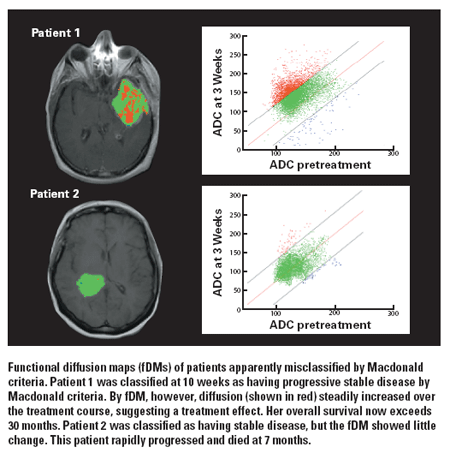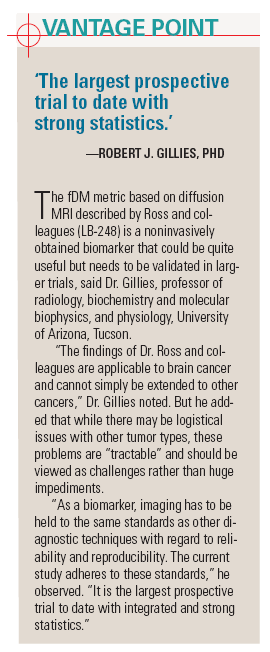Imaging biomarker can predict early treatment response in malignant glioma
In high-grade malignant glioma patients, functional diffusion maps showed tumor response to radiation therapy at 3 weeks after treatment initiation, compared with 10 weeks for traditional volumetric assessment of radiological response.
SAN DIEGO-In high-grade malignant glioma, response to therapy can be assessed early-on and overall survival predicted using functional diffusion mapping (fDM), according to a prospective study that evaluated fDM as an early imaging biomarker.
Brian D. Ross, PhD, graphically showed how fDM corresponds to tumor response as early as 3 weeks after the start of treatment in a presentation at the 2008 American Association for Cancer Research annual meeting (abstract LB-248).

“This is an exciting trial. It is the first of its kind where a diffusion imaging biomarker, fDM, correlated with overall survival,” he noted.
The fDM technique, which assesses early changes in tumors by diffusion MRI, allows physicians to spatially quantify changes within a tumor slice during treatment (see box “How fDM is done”), said Dr. Ross, professor of radiology and biological chemistry and co-director of the Center for Molecular Imaging, University of Michigan, Ann Arbor.
“Diffusion MRI does not necessarily make a better picture of the tumor, but it may be able to assess the response of the tumor to therapy much faster than traditional MRI images,” he said. “In addition, by combining diffusion MRI and conventional MRI, one can get a better measurement of results than could be achieved with either test alone.”
The traditional volumetric assessment of radiological response obtained at 10 weeks after treatment initiation also correlated with outcome, and the two methods were indistinguishable.
“But fDM was obtained only 3 weeks into the treatment, which may provide the clinician an opportunity to switch therapies or redirect radiotherapy to an unresponsive region of the tumor,” Dr. Ross said.
Early treatment response
Dr. Ross and his colleagues assessed the fDM metric in 60 patients with high-grade gliomas undergoing radiation therapy and found measurable changes in diffusion MRI as assessed by fDM as early as the first week of treatment.

Classification by the traditional Macdonald criteria and by fDM was similar in 75% of the cases, but some patients were obviously misclassified by radiological response, Dr. Ross said (see Figure).
The volume of tumor with increased diffusion by fDM at 3 weeks from the start of therapy was the strongest predictor of survival at 1 year, with larger fDM predicting longer median survival: 52.6 months vs. 10.9 months for lower fDM (P < .003). Radiological response (by Macdonald criteria) at 10 weeks was of similar prognostic value when it accounted for steroid dosing (P < .0007), Dr. Ross reported.
Pretreatment age less than 50, pathologic grade (3 vs 4), and the use of concurrent temozolomide (Temodar) also corresponded with improved survival by univariate analysis, but only age and fDM retained prognostic significance in a multivariate analysis. The strongest predictor was the combination of fDM at week 3 and radiological response at week 10.
The use of this imaging biomarker helps attain a clinical goal of the future-individualization of treatment-by providing justification to discontinue treatment that will probably be futile, Dr. Ross emphasized.
Other tumors
The investigators are also evaluating fDM in primary breast cancer, lymphoma, sarcoma, head and neck cancer, and prostate cancer metastatic to the bone.
“We have not found a tumor that we cannot measure in this way. It remains to be seen how far this can be applied, but we are very optimistic that there are no major limitations,” he said.
How fDM is done
Tumor cells restrict the random diffusion of water molecules within a tumor; therefore, diffusion increases during successful therapy that shrinks the tumor. Diffusion MRI, which is often used to evaluate brain injury after stroke, measures the movement of those water molecules and the changes in cellular density.
As tumors respond to treatment, their cell density diminishes, resulting in greater mobility of water and an increase in the apparent diffusion coefficient (ADC) value of the tumor. Tumors with necrosis, for example, have the highest ADC values, and such changes in ADC can be visualized in color: Increased ADC, unchanged ADC, and decreased ADC correspond to a red, blue, or green display on a scatter plot (an fDM map).
